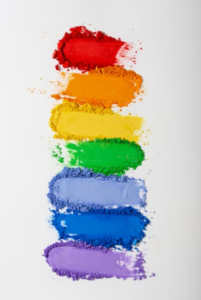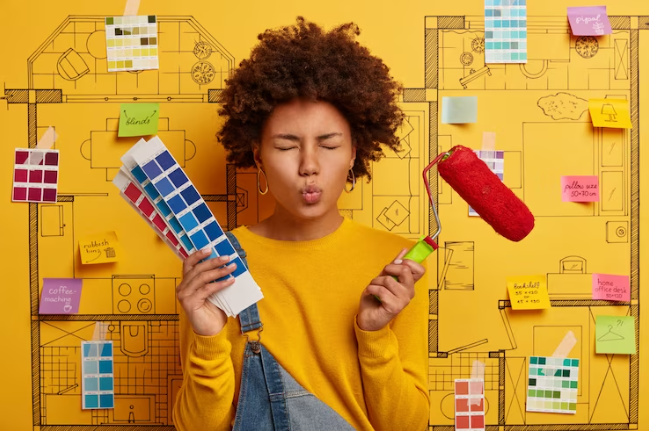Are you planning to do some home repairs or redesigning your living space? One of the most important things to consider is the color of the paint you use. The Colors you choose can have a significant impact on your mood and overall well-being.
Understanding the psychology of colors can help you make informed decisions about which hues to use in each room of your home. Color psychology is the study of how colors affect human emotions and behavior. It is a fascinating field that has been explored by psychologists, designers, and artists for decades.
By understanding the basics of color psychology, you can create a living space that not only looks great but also feels great to be in. In this article, we will examine the different ways in which colors can affect your emotions and provide insights into how to choose the right colors for your home.

The Basics of Color Psychology
You’ll discover the power of hues and how they can impact your mood and behavior, allowing you to create a space that reflects your personality and uplifts your spirits.
Color psychology is a fascinating study that delves into the effects of different hues on human emotions. For instance, warm colors like red, orange, and yellow are known to evoke feelings of excitement, energy, and happiness. Cool colors like blue, green, and purple tend to have a calming and soothing effect on people.
Moreover, color symbolism and cultural influences also play a significant role in how we perceive and respond to different colors. For example, in Western cultures, white is often associated with purity and innocence, while in some Asian cultures, it represents death and mourning. Similarly, red is considered a lucky and auspicious color in Chinese culture, but in some African cultures, it’s associated with danger and aggression.
Understanding the cultural connotations of colors can help you make informed choices when selecting paints for your home.
How Colors Affect Human Emotions
Feeling blue might not be so bad after all – certain colors have the power to influence our emotions in unexpected ways. Color symbolism plays a crucial role in how we perceive and react to different hues.
For example, blue is often associated with calming and soothing feelings, while red can evoke passion and excitement. However, cultural influences can also impact our emotional responses to colors. In some cultures, white is a symbol of purity and peace, while in others it is seen as a symbol of death and mourning.
It’s important to consider the cultural context when choosing colors for your home. For example, if you’re decorating a room for a multicultural family, you may want to avoid using colors that have negative associations in their culture. Additionally, it’s essential to consider the mood you want to create in a particular space.
If you want a room to feel cozy and welcoming, warm colors like red or orange may be a good choice. On the other hand, if you want a space to feel peaceful and serene, cool colors like blue or green may be more appropriate.
By understanding how colors affect our emotions and considering cultural influences, you can choose paint colors that create the desired atmosphere in your home.
Choosing Colors for Different Rooms
As you’re choosing colors for different rooms, it’s important to keep in mind the latest color trends while also staying true to your personal style.
For small spaces, it’s best to stick to light and bright color schemes to create the illusion of a larger space. Consider shades of white, beige, pale blue, or light gray for a calming and airy feel.
For larger rooms, you have more freedom to play with bolder colors and create a statement. You can choose a monochromatic color scheme, where you use different shades of the same color, or a complementary color scheme, where you choose colors that are opposite on the color wheel.
Don’t be afraid to mix and match patterns and textures, such as pairing a solid-colored sofa with patterned pillows or a textured rug. Remember, the colors you choose for your home can greatly impact your mood and overall well-being, so choose wisely.
Using Color to Create a Desired Atmosphere
Transform your living space into a haven of tranquility or an energetic hub of creativity by harnessing the power of color. The right color coordination can make a significant impact on the mood of a room.
For instance, you can choose calming colors like blue, green, and lavender for your bedroom to create a peaceful atmosphere that promotes relaxation and sleep. On the other hand, you can go for vibrant colors like red, yellow, and orange for your living room to create an energizing ambiance that encourages social interaction and conversation.
Cultural influences can also play a significant role in determining the ideal color scheme for your living space. Different cultures have unique color associations and meanings. For instance, in Western cultures, black is often associated with mourning, while in some African cultures, it represents power and prestige.
Therefore, it’s essential to consider your cultural background and the cultural influences that you want to incorporate into your living space when choosing the right colors for your home.
Tips for Successful Color Combinations
To achieve successful color combinations in your living space, you’ll need to consider several factors.
One crucial aspect is the lighting of the room. The amount and type of light can influence how colors appear. For instance, natural light can bring out the true colors of your walls and decor, while artificial light can distort them. It’s vital to test your desired paint colors under different lighting conditions to ensure that they look the way you want them to.
Another important factor to consider is the size of the room. Darker colors can make a small space feel even more cramped, while lighter shades can make it appear more spacious.
Moreover, you need to think about the existing furniture and decor in your room. You can use color contrast to create a focal point or to add depth to your design. For instance, if your sofa is a neutral color, you can use a bold complementary hue on the walls to create a striking contrast.
By following these tips and experimenting with color combinations, you can create a cohesive and harmonious atmosphere that reflects your personal style.
Frequently Asked Questions
Are there any cultural differences in how colors affect emotions?
When it comes to the psychology of colors, it’s important to consider the cultural influences on color psychology. Cross cultural color preferences can vary greatly, with different societies associating certain colors with different emotions.
For example, in Western cultures, black is often associated with mourning and sadness, while in some Asian cultures, white is the color of mourning. Additionally, certain colors may have different meanings or connotations in different cultures.
Understanding these cultural differences is important when choosing colors for a specific audience or setting, as it can impact the emotional response and overall effectiveness of the design.
How do colors affect productivity in a workspace?
When it comes to color scheme selection for a workspace, it’s important to consider the impact it can have on creativity and productivity.
Bright, bold colors like red and yellow can increase energy levels and stimulate creativity, while cooler tones like blue and green can promote a sense of calmness and focus.
However, it’s important to find a balance that works best for you and your specific work needs. Too much stimulation can lead to distraction and overwhelm, while too much calmness can result in lethargy and lack of motivation.
Ultimately, the colors you choose for your workspace should support your work goals and enhance your overall productivity.
Can color psychology be used in exterior home design?
When it comes to exterior palettes, color symbolism plays a crucial role in creating the desired mood and ambiance for your home. The right color combination can evoke feelings of warmth and comfort, while the wrong one can create a sense of coldness and detachment.
It’s important to choose colors that complement your home’s style and architecture, as well as your personal preferences. By selecting a palette that reflects your personality and the surrounding environment, you can create a welcoming space that feels like home.
Whether you’re looking to make a bold statement or create a more subdued atmosphere, understanding the psychology of color can help you achieve your desired outcome.
What are some common mistakes people make when choosing colors for their home?
When it comes to choosing colors for your home, it’s important to understand the basics of color psychology and visual perception.
Many people make the mistake of relying solely on personal preferences, ignoring how different colors can affect their mood, behavior, and perception of space.
Common misconceptions about color psychology include assuming that certain colors have universal meanings or that they always have the same impact on everyone.
In reality, the psychological effects of colors can vary depending on cultural, personal, and contextual factors.
To avoid these mistakes, it’s helpful to do some research, experiment with different color combinations, and seek professional advice if needed.
By being mindful of color psychology and visual perception, you can create a home that feels both aesthetically pleasing and emotionally satisfying.
Is there any scientific evidence to support the claims of color psychology?
Color preferences and the belief in the placebo effect are both intriguing areas of study in the field of psychology. However, the extent of color’s impact on human emotions and behavior is still up for debate. Some studies have suggested that certain colors can evoke specific emotions or influence decision-making. On the other hand, others have found little to no correlation between color and psychological response.
The placebo effect can also play a role in how individuals perceive the impact of color on their mood or behavior. Overall, there may be some scientific evidence to support the claims of color psychology. However, the field is complex and requires further investigation to fully understand the relationship between color and the human mind.
Conclusion
Congratulations! You now have a deeper understanding of the psychology of colors and how to choose paints for your home repair and redesign projects.
By using the principles of color psychology, you can evoke specific emotions and create the desired atmosphere in each room. Remember, warm colors like red and orange can create a sense of excitement and energy, while cool colors like blue and green can promote calmness and relaxation.
When choosing colors for different rooms, consider the function of the space and the emotions you want to evoke. And don’t be afraid to experiment with different color combinations and shades to achieve the perfect look.
By taking the time to understand the psychology of colors and using it to guide your paint choices, you can transform your space into a beautiful and functional reflection of your personal style and taste.
So go ahead, let your creativity run wild and have fun with your home repair and redesign projects!

